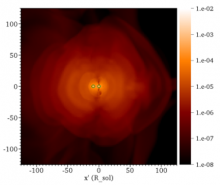
Abstract
Common envelope evolution (CEE) is presently a poorly understood, yet critical, process in binary stellar evolution. Characterizing the full 3D dynamics of CEE is difficult in part because simulating CEE is so computationally demanding. Numerical studies have yet to conclusively determine how the envelope ejects and a tight binary results, if only the binary potential energy is used to propel the envelope. Additional power sources might be necessary and accretion onto the inspiraling companion is one such source. Accretion is likely common in post-asymptotic giant branch (AGB) binary interactions but how it operates and how its consequences depend on binary separation remain open questions. Here we use high resolution global 3D hydrodynamic simulations of CEE with the adaptive mesh refinement (AMR) code AstroBEAR, to bracket the range of CEE companion accretion rates by comparing runs that remove mass and pressure via a subgrid accretion model with those that do not. The results show that if a pressure release valve is available, super-Eddington accretion may be common. Jets are a plausible release valve in these environments, and they could also help unbind and shape the envelopes.